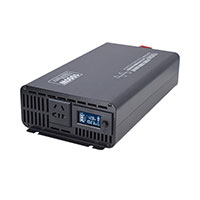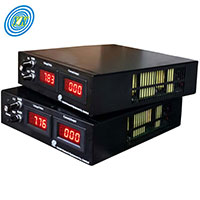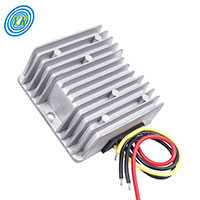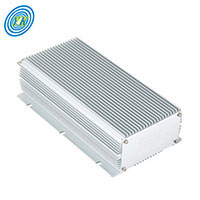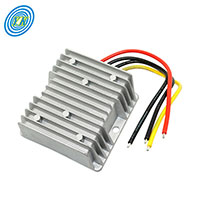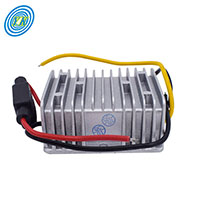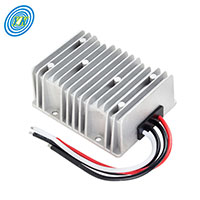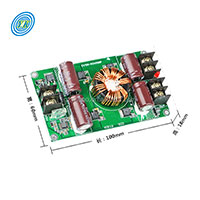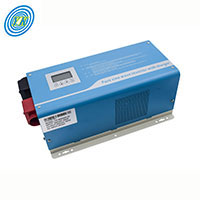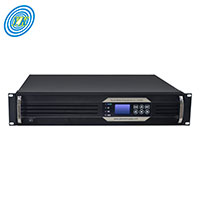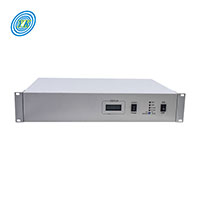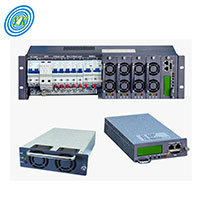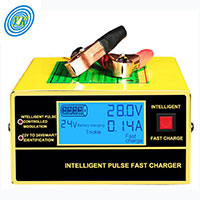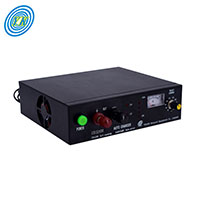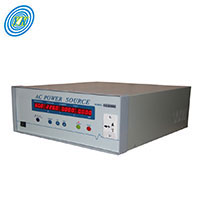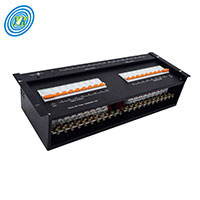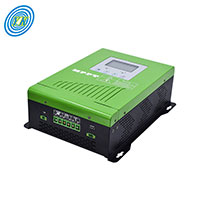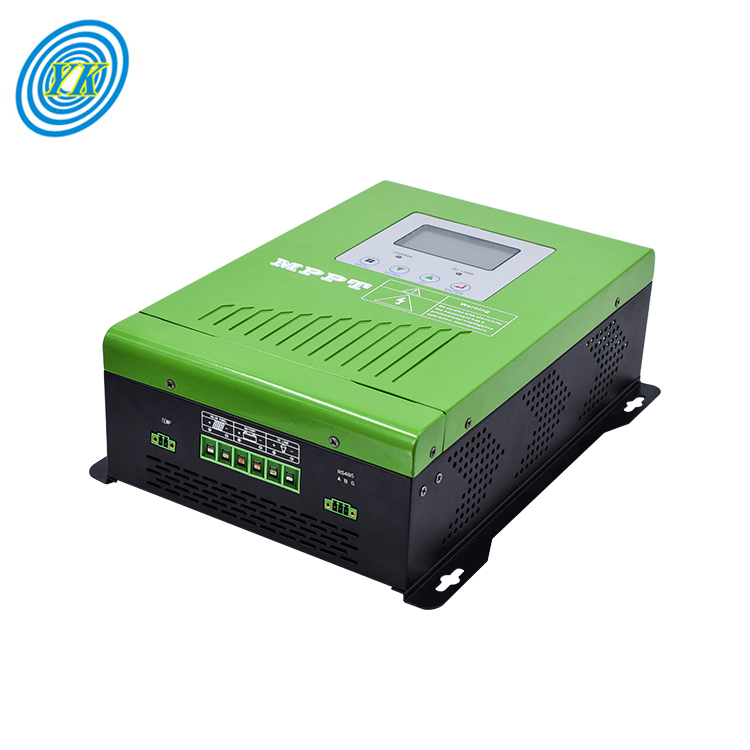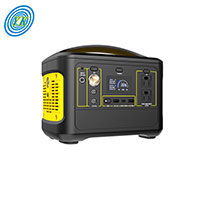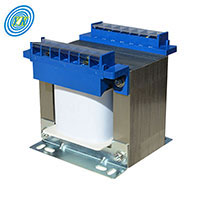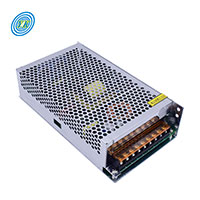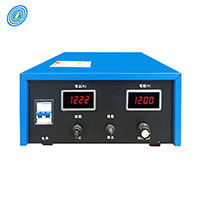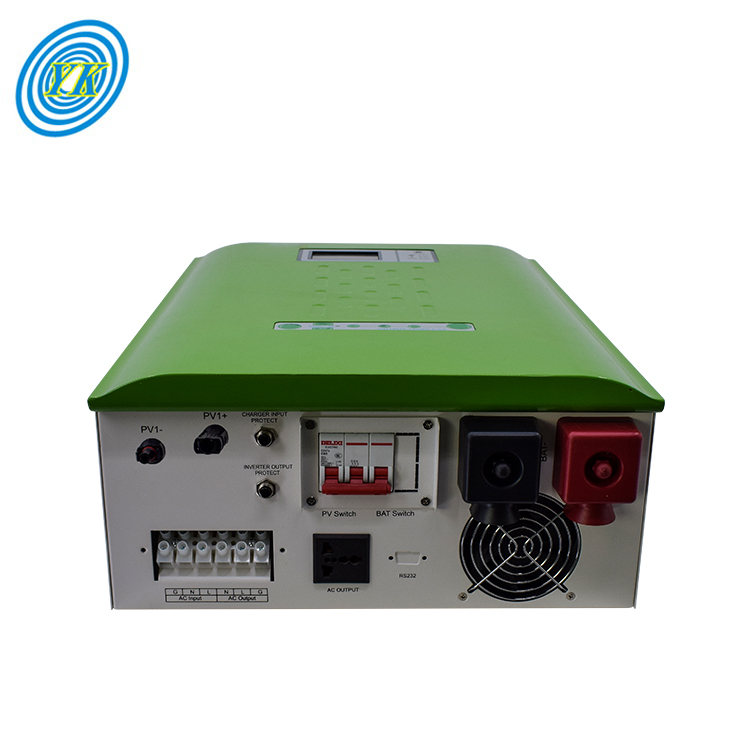
Click: 182 Date: 11/22/2023 4::34::09 PM
An In-depth Exploration of Integrated Inverter Controller Machines: From Origins to Selection, Features, and a Case Study on YUCOOIntroduction:Tracing the Origins of Integrated Inverter Controller MachinesThe origins of integrated inverter controller machines can be traced back to the development of power conversion technology. The initial form of power conversion was the transformer, which could only convert the voltage level of alternating current (AC) while maintaining the same frequency. However, with the increasing demand for direct current (DC) in many applications such as electronics, the need for a device that could convert AC to DC and vice versa became apparent. This led to the invention of inverters.Inverters, in their simplest form, convert DC to AC. The earliest inverters, known as rotary inverters or motor-generator sets, were mechanical devices that used a DC motor to drive an AC generator. These devices, however, were bulky, inefficient, and required a significant amount of maintenance.With the advent of solid-state electronics in the mid-20th century, electronic inverters were developed. These devices used power semiconductors to switch the DC input on and off at a high frequency, creating a square wave output. Although these devices were more compact and efficient than their mechanical predecessors, the quality of the output waveform was poor, which limited their applications.The next major advancement in inverter technology came with the development of pulse-width modulation (PWM), which allowed for the creation of a near-sinusoidal output waveform. This greatly expanded the range of applications for inverters, enabling their use in sensitive electronic devices and high-performance electric drives.At the same time, the complexity of inverter operation and the need for precise control over the output waveform led to the development of inverter controllers. These devices use sophisticated algorithms to control the switching of the power semiconductors, optimizing the inverter's performance, efficiency, and reliability.The integration of the inverter and its controller into a single device, known as an integrated inverter controller machine, is a relatively recent development. This integration simplifies the design and installation of power conversion systems, reduces cost, and improves reliability by eliminating the need for separate devices and interconnecting wiring.The evolution of integrated inverter controller machines has been driven by ongoing advances in power electronics, digital control technology, and semiconductor materials. Today, these machines are used in a wide range of applications, from renewable energy systems to electric vehicles, demonstrating the significant progress that has been made since the early days of power conversion technology.Exploring the Variety of Integrated Inverter Controller MachinesBased on Output Waveform:Square Wave Inverters: These are the simplest and cheapest type of inverter. They produce a square wave output, which is not suitable for most sensitive electronic devices. Modified Sine Wave Inverters: These produce an output that is closer to a true sine wave, allowing them to be used with a wider range of devices. However, they may still cause problems with some sensitive electronics or complex loads. Pure Sine Wave Inverters: These produce a smooth, pure sine wave output that is identical to the power supplied by the electrical grid. They can be used with almost any type of AC device and are generally the most expensive type of inverter。Based on Operation Method:Stand-alone Inverters: These inverters are used in off-grid systems where the inverter takes DC power from a battery and converts it into AC power for use.Grid-tie Inverters: These inverters are used in grid-connected systems where the inverter converts DC power produced by solar panels or other renewable energy sources into AC power that can be fed into the electrical grid.Battery Backup Inverters: These inverters are capable of supplying AC power to selected loads during a utility outage, and they are also capable of charging a battery bank when utility AC power is available.Based on Applications:Solar Inverters: These are used in solar power systems to convert the DC power produced by solar panels into AC power that can be used in the home or fed into the electrical grid.Wind Inverters: These are used in wind power systems to convert the DC power produced by wind turbines into usable AC power.EV Inverters: These are used in electric vehicles to convert the DC power from the battery into AC power for the electric motor.The technology used in integrated inverter controller machines has also evolved, with advancements in power semiconductors, digital control algorithms, and power electronics design techniques leading to improvements in efficiency, reliability, and performance. Some of the key technologies used in these machines include IGBTs (Insulated Gate Bipolar Transistors) or MOSFETs (Metal-Oxide-Semiconductor Field-Effect Transistors) for power switching, DSPs (Digital Signal Processors) or microcontrollers for control, and advanced power electronics topologies such as multi-level inverters for improved output waveform quality.How to Choose a Good Integrated Inverter Controller MachineChoosing a good integrated inverter controller machine involves several considerations. Here are some key factors to consider:Power Output: This is one of the most important factors to consider. The power output of the inverter should match the total power requirement of the devices it will be powering. It's usually recommended to choose an inverter with a capacity 20-25% higher than the total load to account for power surges when devices are turned on.Efficiency: The efficiency of an inverter refers to the ratio of power output to power input. An efficient inverter will convert the maximum amount of input power into output power, with minimal losses. This is particularly important in battery-powered systems, where inefficient conversion can quickly drain the batteryDurability: The inverter should be durable and capable of withstanding the environmental conditions in which it will be operating. This includes factors like temperature, humidity, and the presence of dust or other contaminantsCost: While it can be tempting to opt for the cheapest option, it's important to consider the long-term costs. A cheap inverter may have a lower upfront cost, but if it's inefficient or unreliable, it could end up costing more in the long runType of Load: Different types of loads (resistive, inductive, capacitive) require different types of inverters. For instance, sensitive electronic devices usually require a pure sine wave inverter, while simpler devices like heaters can work with modified sine wave invertersFeatures: Look for features like overload protection, short-circuit protection, thermal protection, and auto restart function. Some inverters also come with digital displays that show important information like battery voltage, output power, and fault codesManufacturer Reputation: Choose a reputable manufacturer that offers good customer support and warranty. A manufacturer with a proven track record in the industry is more likely to produce reliable, high-quality invertersRegulatory Compliance: The inverter should comply with all applicable safety and electromagnetic compatibility (EMC) standards. Compliance with these standards ensures that the inverter is safe to use and won't interfere with other electronic devices.Understanding your specific power needs and the application for which the machine will be used is crucial in making the right selection. For instance, if you are choosing an inverter for a solar power system, you may need a grid-tie inverter with maximum power point tracking (MPPT) to maximize the power output from your solar panels. If you're choosing an inverter for a wind power system, you'll need an inverter that can handle the variable power output of the wind turbine.Understanding the Features of Integrated Inverter Controller MachinesIntegrated inverter controller machines come with a host of features that enhance their performance, efficiency, and usability. Here are some key features and their implications:Integrated Control: The integration of the inverter and controller into a single device simplifies system design and installation, reduces the need for interconnecting wiring, and improves reliability. The controller can optimize the operation of the inverter in real-time, enhancing performance and efficiencyOutput Waveform Quality: Higher quality inverters produce a pure sine wave output that closely matches the power from the electrical grid. This allows them to power sensitive electronic devices without risk of damage or performance issues. On the other hand, cheaper inverters that produce a modified sine wave or square wave output may not be suitable for all devicesEfficiency: The efficiency of an inverter controller machine is a measure of how much of the input power is converted into output power. Higher efficiency means less energy is wasted, which is particularly important in battery-powered or renewable energy systemsPower Output Capacity: The power output capacity of the inverter should be sufficient to power all the intended devices. Some inverters also have a surge capacity that allows them to handle higher power levels for short periods, which is useful when starting devices with high inrush currentsProtection Features: Many inverters come with protection features such as overload protection, short-circuit protection, over-temperature protection, and low battery shutdown. These features protect both the inverter and the connected devices from damageUser Interface: Some inverters come with a digital display or indicator lights that provide information on the operating status of the inverter, including output power, input voltage, and any fault conditionsCommunication Features: Some high-end inverters offer communication features that allow them to be monitored and controlled remotely. This can be particularly useful in large systems or installations where the inverter is not easily accessible.While these features can enhance the functionality and usability of the inverter, they can also add to its complexity and cost. For instance, a pure sine wave inverter is more expensive than a modified sine wave or square wave inverter. Similarly, inverters with advanced features like remote monitoring and control are likely to be more expensive than basic models. Therefore, when choosing an inverter, it's important to balance the need for these features against the available budget.A Detailed Introduction to YUCOO, a Renowned Manufacturer of Integrated Inverter Controller MachinesYUCOO is a leading manufacturer of integrated inverter controller machines with over 20 years of experience in the industry. The company has built a strong reputation for its commitment to quality, innovation, and customer satisfaction.Founded two decades ago, YUCOO started with a vision to deliver high-quality power conversion solutions that meet the evolving needs of customers. Over the years, the company has grown significantly, expanding its product range and establishing a global presence.YUCOO offers a wide range of integrated inverter controller machines, designed to cater to various applications and power requirements. Their product line includes pure sine wave inverters, modified sine wave inverters, and square wave inverters, with power capacities ranging from low to high. They also offer specialized inverters for specific applications like solar power systems, wind power systems, and electric vehicles.What sets YUCOO apart in the market is their focus on technological innovation and quality. Their inverters are known for their high efficiency, reliability, and durability. They feature advanced control algorithms that optimize performance, sophisticated protection features for enhanced safety, and user-friendly interfaces for easy operation. Many of their models also come with remote monitoring and control capabilities, offering added convenience for users.YUCOO's commitment to quality is evident in their rigorous quality control processes. Each of their products undergoes stringent testing to ensure it meets the highest standards of performance and reliability. As a testament to their confidence in their products, YUCOO offers excellent warranty terms and after-sales support, providing customers with peace of mind.In addition to their high-quality products, YUCOO is also known for their exceptional customer service. They have a team of technical experts ready to assist customers with product selection, installation, troubleshooting, and maintenance. This customer-centric approach has earned them the trust and loyalty of customers worldwide.In conclusion, YUCOO stands out as a manufacturer of integrated inverter controller machines with their commitment to quality, innovation, and customer satisfaction. Whether you're looking for a simple inverter for a small application or a sophisticated inverter for a large, complex system, YUCOO has a solution to meet your needs.
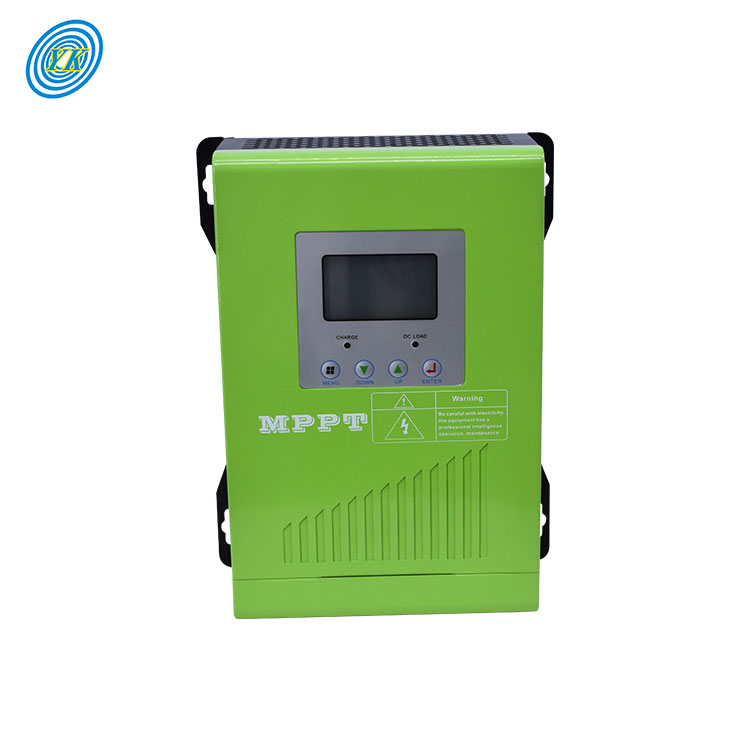
Click: 887 Date: 11/21/2023 09::11::29 AM
Comprehensive Overview of MPPT Controllers: Exploring Origins, Varieties, Selection Criteria, Features, and a Deep Dive into YUCOOIntroduction:Unveiling the Origins and Introduction of MPPT ControllersMPPT, or Maximum Power Point Tracking, is a technique used primarily in photovoltaic (PV) solar systems to maximize power extraction under all conditions. The origins of MPPT controllers can be traced back to the late 1970s and early 1980s, when solar energy began to be seen as a viable alternative energy source.The first MPPT controllers were simple, with limited efficiency. As technology advanced, so did the capabilities of these controllers. The main purpose of an MPPT controller is to match the output of the PV cells to the battery's voltage to achieve maximum power.In the context of PV systems, the MPPT is the "condition" of solar irradiance and temperature resulting in the maximum power output. The role of the MPPT controller is to keep the PV system operating at this point as conditions change throughout the day and year.One of the early innovators in this field is YUCOO, a company with over 20 years of experience in the industry. YUCOO has been instrumental in driving the innovation and development of MPPT controllers, contributing to the technology's evolution over time. The company's controllers are known for their high efficiency and reliability, making them a preferred choice for many customers worldwide.Over the years, MPPT controllers have become more sophisticated, incorporating advanced algorithms and digital control systems to optimize their performance. These improvements have made it possible to extract more power from PV systems, making solar energy an increasingly economical choice for power generation.Today, MPPT controllers are an essential component of any solar PV system, playing a critical role in maximizing the system's overall performance. They represent a significant milestone in our ongoing quest to harness the power of the sun more effectively and efficiently.Exploring the Different Types of MPPT ControllersMPPT controllers come in various types, each with its own set of features and applications. The primary types of MPPT controllers can be categorized based on their tracking algorithms, namely: Perturb and Observe (P&O), Incremental Conductance (IncCond), and Constant Voltage (CV).Perturb and Observe (P&O): This is the most common technique used in MPPT controllers. The algorithm works by perturbing (i.e., slightly increasing or decreasing) the system's operating voltage and observing the effect on the power output. If the power increases, the perturbation continues in the same direction. If the power decreases, the perturbation reverses.Incremental Conductance (IncCond): The IncCond method is more complex than P&O but offers better performance under rapidly changing atmospheric conditions. The algorithm operates on the principle that the derivative of the power with respect to voltage is zero at the maximum power point and uses this fact to track the maximum power point.Constant Voltage (CV): The CV method assumes a fixed relationship between the maximum power point voltage and the open-circuit voltage. This technique is simpler than the others but may not always be accurate, as the relationship can vary based on atmospheric conditions.YUCOO, as a leading manufacturer of MPPT controllers, offers a variety of products employing these different tracking techniques. Their MPPT controllers are designed for high efficiency, flexibility, and reliability, catering to a wide range of solar PV systems. The company's products are a testament to the advancements in MPPT technology, offering superior performance and versatility to meet the needs of diverse applications.In addition to these, there are also hybrid MPPT controllers that combine the strengths of different tracking techniques to optimize performance under all conditions. As technology progresses, we can expect to see more innovative and efficient MPPT controllers in the future.Guidelines for Choosing a Quality MPPT ControllerChoosing a quality MPPT controller is critical to the efficiency and longevity of your solar PV system. Here are some guidelines to consider:Compatibility: Ensure that the MPPT controller is compatible with your solar panel system in terms of voltage and current ratings.Efficiency: Look for an MPPT controller with high efficiency. A higher efficiency means more power is converted from your solar panels to your batteryTracking Algorithm: As mentioned earlier, MPPT controllers use different tracking algorithms. Choose one that suits your needs and local weather conditions.Features: Look for additional features like data logging, remote monitoring, and control capabilities. These can help you better manage and monitor your solar system.Reliability and Durability: The controller should be robust and durable, capable of withstanding harsh environmental condition.Brand Reputation and Reviews: Consider the reputation of the brand and reviews from other customers. A well-known brand like YUCOO, with positive customer feedback, indicates quality and reliability.YUCOO's MPPT controllers, for instance, are a great example of quality products in the market. They are designed for high efficiency, using advanced tracking algorithms. They come with robust features such as data logging and remote monitoring capabilities. With a strong track record in the industry and positive customer reviews, YUCOO's products are a testament to the company's commitment to quality and innovation.Remember, a quality MPPT controller is an investment that will pay off in the long run by maximizing the performance and lifespan of your solar PV system.Understanding the Unique Features of MPPT ControllersMPPT Controllers come with several unique features that set them apart from other types of solar charge controllers. Here are some of these features:Maximum Power Point Tracking: As their name suggests, MPPT controllers track the maximum power point of solar panels, ensuring the most efficient energy extraction at any given time. This is their primary feature and what makes them particularly valuable in solar PV systems.Efficiency: MPPT controllers are known for their high efficiency. They can convert excess voltage into amperage, resulting in nearly 30% more efficiency than traditional PWM controllers.Versatility: MPPT controllers are versatile and can be used with a wide range of solar panel inputs with various voltage outputs. They can convert high voltage outputs from solar panels to a lower voltage suitable for battery charging.Advanced Algorithms: MPPT controllers use advanced algorithms to track the maximum power point accurately, even under changing weather conditions.Additional Features: Many MPPT controllers come with extra features like data logging, remote monitoring, and control capabilities, enhancing user convenience and system management.Scalability: MPPT controllers are scalable, meaning you can add more solar panels to your system without needing to replace the controller, as long as you don't exceed its maximum input capacity.YUCOO's MPPT controllers exemplify these features. They offer high efficiency, versatility, and come with advanced features for improved user experience. They use sophisticated tracking algorithms to ensure optimal performance under various conditions. Plus, their scalability makes them a suitable choice for both small and large solar installations.In summary, the unique features of MPPT controllers contribute significantly to their effectiveness, making them an essential component in any solar PV system.Profiling YUCOO: A Renowned Manufacturer of MPPT ControllersYUCOO is a globally recognized manufacturer of MPPT controllers, with over 20 years of experience in the industry. The company has been at the forefront of technological advancements in the field, consistently delivering high-quality products that cater to a wide range of applications.YUCOO's product line is characterized by high efficiency, reliability, and versatility. Their MPPT controllers come equipped with advanced tracking algorithms that ensure maximum power extraction from solar panels under varying conditions. The controllers also offer high compatibility, capable of working with different types and sizes of solar installations.In addition to quality products, YUCOO places a strong emphasis on customer service. They offer comprehensive after-sales support, ensuring that customers can get the most out of their products. This focus on customer satisfaction has earned them a strong reputation in the market and a loyal customer base.YUCOO's commitment to innovation is evident in their product development efforts. They continuously invest in research and development to stay ahead of industry trends and to provide their customers with the latest and most efficient MPPT technology.Moreover, YUCOO's MPPT controllers come with robust features such as data logging and remote monitoring capabilities, allowing users to manage their solar systems more effectively. These features, coupled with their high efficiency and reliability, make YUCOO's products a preferred choice for many customers worldwide.In conclusion, YUCOO's extensive experience, commitment to quality and innovation, and focus on customer service make them a leading player in the MPPT controller industry. Whether you're setting up a small residential solar system or a large-scale commercial installation, YUCOO's range of MPPT controllers offers a reliable and efficient solution for your needs.
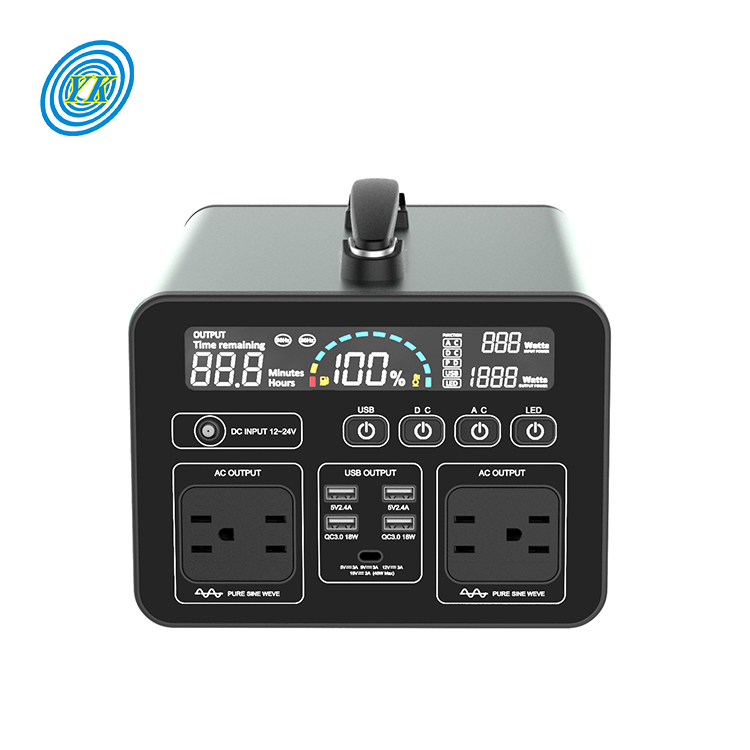
Understanding Energy Storage Systems: An In-depth Analysis and Review of YUCOO Power Solutions
Click: 847 Date: 11/20/2023 4::21::15 PM
Understanding Energy Storage Systems: An In-depth Analysis and Review of YUCOO Power SolutionsIntroduction:The Origins and Evolution of Energy Storage SystemsEnergy storage systems refer to the methods used to store energy that can be used at a later time. The concept isn't new and has been in use in various forms for centuries. The earliest forms of energy storage were mechanical in nature, such as the use of water wheels. Over time, these systems evolved into more sophisticated forms, such as pumped hydro storage and thermal storage.Pumped hydro storage, one of the earliest and most commonly used forms of energy storage, works by pumping water uphill to a storage reservoir when there's excess electricity. This stored energy is then released by letting the water flow downhill to generate electricity when needed. Thermal storage, on the other hand, stores energy in the form of heat or cold, which can be used to produce electricity or for heating and cooling applications.The evolution of energy storage systems has been driven largely by advancements in technology. For instance, the development of new materials and manufacturing techniques has led to the creation of more efficient and compact energy storage systems, such as batteries. These advancements have not only made energy storage systems more affordable and accessible but also enabled their use in a wider range of applications, from grid storage to electric vehicles.Companies like YUCOO have been at the forefront of this evolution. With over 20 years of experience in the energy storage industry, YUCOO has been instrumental in driving the development and adoption of advanced energy storage solutions. Their products, which range from home energy storage systems to large-scale grid storage solutions, are renowned for their reliability and efficiency, and are used by customers around the world.YUCOO's contribution to the energy storage industry is a testament to the pivotal role that technology and innovation play in driving the evolution of energy storage systems. As technology continues to advance, we can expect to see even more sophisticated and efficient energy storage solutions in the future.Types of Energy Storage SystemsEnergy storage systems can be classified into several types, each with its own strengths and weaknesses. Here are the main types:Batteries: Battery energy storage systems store energy in a chemical form. This stored energy can be released as electricity when needed. The most common types of batteries used for energy storage are lead-acid and lithium-ion batteries. Lithium-ion batteries, in particular, have gained popularity due to their high energy density and long lifespan. However, they are more expensive and have potential safety issues if not properly managed.Flywheels: Flywheel energy storage systems store energy kinetically in a rotating mass. They can deliver power instantly but for a short duration. Flywheels are highly efficient, have a long lifespan, and can undergo many charge-discharge cycles without significant degradation. However, they require a high initial investment and sophisticated control systems.Compressed Air Energy Storage (CAES): CAES systems store energy by compressing air in an underground reservoir. The compressed air is heated and expanded in a turbine to generate electricity when needed. CAES systems are cost-effective and can store energy for long periods, but their efficiency is relatively low, and they require specific geological formations to store the compressed air.Pumped Hydro Storage (PHS): As mentioned earlier, PHS systems store energy by pumping water uphill during periods of low demand and releasing it to generate electricity during periods of high demand. PHS systems are highly efficient and can store large amounts of energy, but they are geographically constrained and have high upfront costs.YUCOO specializes in battery energy storage systems, particularly lithium-ion batteries. Their products are known for their high energy density, long lifespan, and excellent performance. YUCOO's battery systems are designed with advanced control systems to ensure safety and reliability, making them a preferred choice for both residential and commercial energy storage applications.How to Choose a Good Energy Storage SystemChoosing the right energy storage system depends on several factors:Energy Efficiency: The efficiency of an energy storage system refers to the amount of energy that can be retrieved compared to the amount of energy stored. High-efficiency systems ensure that minimal energy is lost during the storage and retrieval process.Life Cycle: This refers to the number of charge-discharge cycles a system can undergo before its performance degrades significantly. A longer life cycle is desirable as it means the system won't need to be replaced as frequently.Safety: Safety considerations are paramount, especially for chemical storage systems like batteries which can pose fire risks if not properly managed. Look for systems that have built-in safety features and comply with relevant safety standards.Cost: This includes both the upfront costs of the system and the ongoing costs of operation and maintenance. While cheaper systems may seem attractive, they can end up being more expensive in the long run if they have high operating costs or a short lifespan.Size and Scalability: Depending on the application, you might need a system that can scale up or down easily. For instance, a home energy storage system might not need to be as large or scalable as a grid storage system.YUCOO's energy storage systems excel in all these aspects. Their lithium-ion batteries are highly efficient and have a long life cycle, providing excellent value for money. YUCOO's systems are also designed with safety in mind, featuring advanced control systems that monitor the system's performance and prevent issues like overcharging or overheating. Furthermore, YUCOO offers a range of products to suit different needs, from compact systems for residential use to large-scale systems for commercial or grid storage. These features make YUCOO's energy storage systems a preferred choice among customers.Understanding the Features of Energy Storage SystemsEnergy storage systems come with several unique features that make them a valuable addition to both power grids and individual homes:Reliability: Energy storage systems can provide a reliable supply of power, even in situations where the grid is unstable or during power outages. They can also smooth out the supply of power from renewable sources, which can be intermittent.Flexibility: Energy storage systems can be used in a variety of applications, from supplying power during peak demand periods to stabilizing the grid. They can also be scaled up or down to match the needs of the user.Sustainability: By enabling the integration of more renewable energy into the grid, energy storage systems can contribute to sustainability efforts. They can store excess power produced by renewable sources and supply it when needed, reducing reliance on fossil fuels.YUCOO's energy storage systems embody these features. Their products are known for their reliability, with advanced control systems that ensure a stable power supply under various conditions. They offer a range of products that can be used in different applications, from home energy storage to grid storage, demonstrating their flexibility. And by leveraging high-efficiency lithium-ion batteries, YUCOO's systems can store and supply power from renewable sources, contributing to sustainability efforts. In this way, YUCOO's products not only provide practical benefits to users but also contribute to larger societal goals like energy security and sustainability.YUCOO: A Renowned Manufacturer of Energy Storage SystemsYUCOO is a renowned name in the field of energy storage systems. With over 20 years of experience in the industry, the company has established itself as a trusted provider of advanced energy storage solutions.Founded with the mission to provide reliable and efficient energy storage solutions, YUCOO has consistently stayed true to its purpose. The company believes in leveraging technology to drive the adoption of sustainable energy practices, and this is evident in their product offerings.YUCOO specializes in battery energy storage systems, particularly lithium-ion batteries. Their product line ranges from compact home energy storage systems to large-scale grid storage solutions. Each product is designed with attention to efficiency, reliability, and safety. YUCOO's advanced control systems ensure optimal performance and longevity of their products, making them a preferred choice among customers.The quality of YUCOO's products has not gone unnoticed. Over the years, the company's energy storage solutions have gained global recognition. Customers around the world trust YUCOO for their energy storage needs, testament to the company's commitment to quality and customer satisfaction.In conclusion, YUCOO's rich history, mission, and globally recognized product offerings make it a leading player in the energy storage industry. As the world continues to embrace sustainable energy practices, companies like YUCOO will play a crucial role in shaping the future of energy.
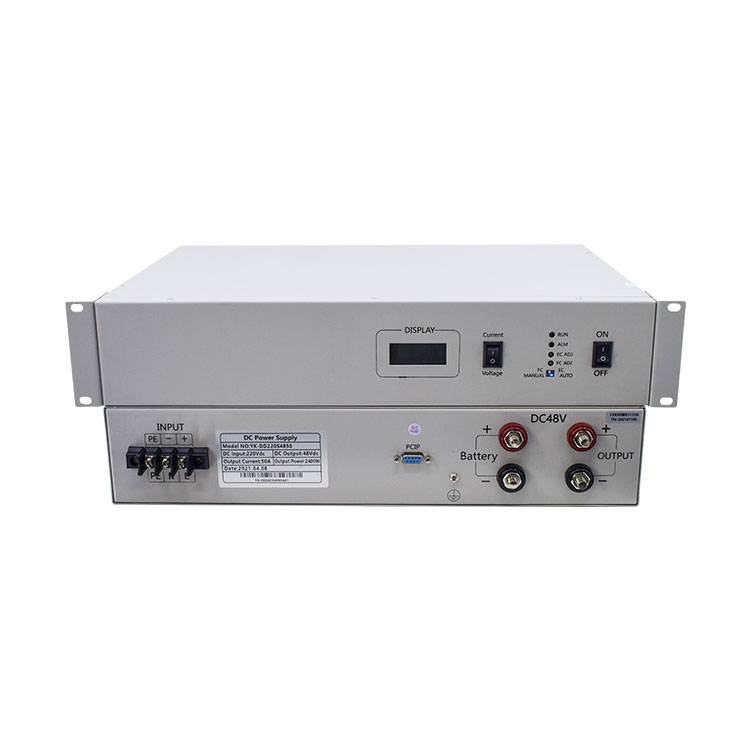
Exploring Switching Power Supplies: A Comprehensive Guide with a Focus on YUCOO
Click: 894 Date: 11/18/2023 09::09::09 AM
Exploring Switching Power Supplies: A Comprehensive Guide with a Focus on YUCOOIntroduction:The Origins and Evolution of Switching Power SuppliesSwitching power supplies, also known as switch-mode power supplies (SMPS), are an essential component in many electronic devices. They function to convert the electrical power efficiently with a high level of efficiency. Unlike linear power supplies, which dissipate excess power as heat, SMPS rapidly switch a power transistor between saturation (full-on) and cutoff (completely off) with minimal energy wasted.The origins of switching power supplies can be traced back to the early 20th century. The first switching power supply was patented by British inventor Philip H. Smith in 1904. However, they did not become popular until the late 1960s and early 1970s, when the demand for more efficient power supplies in computers and other electronics began to rise.The development and advancement of switching power supplies have been driven by the increasing need for power efficiency and miniaturization in the electronics industry. Over the years, improvements in semiconductor technology, control strategies, and integration have led to the production of more compact, efficient, and reliable switching power supplies.In the 1970s and 1980s, advancements were made in the development of high-frequency SMPS. These power supplies offered significant efficiency improvements over linear regulators. During this time, the evolution of power MOSFET and power IC technologies played a crucial role in the advancement of SMPS technology.In the 1990s, the focus shifted towards improving the power density and reliability of SMPS. This led to the development of more compact and reliable power supplies that were suitable for a wide range of applications.In the 21st century, with the rise of portable electronics and the need for energy conservation, the demand for highly efficient, small, and lightweight power supplies has been greater than ever. This has led to further advancements in SMPS, including the development of digital power supplies and the integration of power supplies onto chips for use in microprocessors and other integrated circuits.Today, switching power supplies are a critical component in almost every electronic device, from computers and televisions to mobile phones and electric vehicles. The evolution of SMPS technology continues to be driven by the ongoing need for power efficiency, miniaturization, and cost reduction in the electronics industry.Various Types of Switching Power SuppliesSwitching power supplies can be classified in several ways, including based on their input and output power, and their functionality. Each type has unique features and uses.Classification Based on Input and Output PowerAC to DC (Rectifier) Power Supplies: These power supplies convert alternating current (AC) to direct current (DC). They are widely used in various applications such as computers, televisions, and battery chargers.DC to DC (Converter) Power Supplies: These power supplies convert one level of DC voltage to another level. They are often used in portable devices and cars.AC to AC (Inverter) Power Supplies: These power supplies convert one level of AC voltage to another level. They are frequently used in air conditioners and power backup systems.DC to AC (Inverter) Power Supplies: These power supplies convert DC voltage to AC voltage. They are commonly used in solar power systems and uninterruptible power supplies (UPS)..Classification Based on FunctionalityStep-Down (Buck) Converters: These power supplies reduce the input voltage to a lower output voltage. They are often used in battery-operated devices and USB chargers.Step-Up (Boost) Converters: These power supplies increase the input voltage to a higher output voltage. They are typically used in car battery chargers and portable electronic devices.Voltage-Inverting Converters: These power supplies invert the polarity of the input voltage. They are used in specialized applications such as certain types of audio equipment.Flyback Converters: These power supplies provide isolation between input and output and can produce multiple output voltages. They are commonly used in televisions and computer monitors.Forward Converters: Like Flyback converters, these provide isolation but are generally used for higher power applications. They are often found in telecom and industrial power supplies.Each type of switching power supply has unique features and uses. For example, AC to DC power supplies are essential for powering most electronic devices, while DC to AC power supplies are crucial for inverting DC power from batteries or solar panels into usable AC power. Understanding these differences is important when selecting the right power supply for a particular application.How to Choose a High-Quality Switching Power SupplyChoosing a high-quality switching power supply is crucial for the performance and longevity of your electronic devices. Here are some factors to consider when selecting a switching power supply and common mistakes to avoid:Factors to ConsiderPower Requirement: Evaluate your device's power requirements. This includes the voltage, current, and total power output (usually in watts).Efficiency: High-efficiency power supplies waste less power as heat, reducing energy costs and extending the lifespan of the power supply and your device.Input Voltage Range: Ensure the power supply can operate within the voltage levels available at your location.Safety Standards: Check if the power supply complies with the relevant safety standards in your region.Size and Form Factor: Consider the physical size and shape of the power supply. It should fit within your device or system.Cooling Requirements: Some power supplies may require additional cooling, such as fans or heat sinks.Common Mistakes to AvoidIgnoring Power Requirements: Not matching your device's power requirements with the power supply can lead to poor performance or damage.Overlooking Efficiency: A power supply with low efficiency can lead to higher energy costs and potential overheating.Ignoring Safety Standards: Using a power supply that doesn't meet safety standards can pose a risk to the device and users.YUCOO's Standout FeaturesYUCOO's switching power supplies stand out in each of these aspects:Wide Range of Power Outputs: YUCOO offers a broad range of power supplies to meet various power requirements.High Efficiency: YUCOO's power supplies are designed for high efficiency, reducing energy costs and heat output.Compliance with Safety Standards: All YUCOO power supplies comply with international safety standards.Compact Design: YUCOO power supplies are designed to be compact and fit in a variety of systems.Reliable and Durable: With over 20 years of experience in the industry, YUCOO's power supplies are reliable and built to last.By considering these factors and avoiding common mistakes, you can select a high-quality switching power supply that meets your needs. YUCOO's product range offers a wide selection of high-quality, efficient, and reliable power supplies to choose from.Understanding the Characteristics of Switching Power SuppliesSwitching power supplies, or switch-mode power supplies (SMPS), have unique characteristics that differentiate them from other types of power supplies. Understanding these characteristics can help you better appreciate their benefits and limitations.Key Features of Switching Power SuppliesHigh Efficiency: SMPS function by switching a power transistor between saturation and cutoff, minimizing wasted energy as heat and resulting in high efficiency.Size and Weight: Due to high efficiency and high-frequency operation, SMPS can be made smaller and lighter than linear power supplies.Wide Input Voltage Range: SMPS can handle a wide range of input voltages, making them versatile for different applications.Output Regulation: SMPS have excellent output voltage regulation, maintaining a steady output even with changes in input voltage or load.Benefits and Limitations of Switching Power SuppliesThe key benefits of SMPS include their high efficiency, compact size, light weight, and excellent output regulation. These characteristics make SMPS ideal for a wide range of applications, from consumer electronics to industrial equipment.However, SMPS also have some limitations. For example, they can generate electrical noise due to their high-frequency operation. This noise can interfere with other electronic devices if not properly shielded or filtered. Also, SMPS are more complex than linear power supplies, which can make them more expensive to design and manufacture.How YUCOO's Switching Power Supplies Capitalize on These FeaturesYUCOO leverages the key features of SMPS to create high-quality power supplies:High Efficiency: YUCOO's power supplies are designed for maximum efficiency, reducing energy costs and heat output.Compact Size and Light Weight: YUCOO utilizes advanced technology to design compact and lightweight power supplies without compromising performanceWide Input Voltage Range: YUCOO's power supplies can operate over a wide range of input voltages, making them suitable for various applications worldwide..Excellent Output Regulation: YUCOO's power supplies maintain a steady output, ensuring reliable operation of your devices.Noise Reduction: YUCOO implements effective shielding and filtering techniques to minimize electrical noise generated by its power supplies.By understanding the characteristics of SMPS and how YUCOO capitalizes on these features, you can appreciate the advantages offered by YUCOO's switching power supplies.A Detailed Introduction to YUCOO, a Leading Manufacturer of Switching Power SuppliesOverview of YUCOOYUCOO is a renowned manufacturer of switching power supplies with over 20 years of experience in the industry. Known for its commitment to quality, innovation, and customer satisfaction, YUCOO has built a strong reputation as a trusted provider of reliable, high-performance power supplies. The company's products are used in a wide range of applications, from consumer electronics to industrial equipment, and are exported globally.YUCOO's Journey in the Switching Power Supply IndustryYUCOO's journey in the switching power supply industry is a story of continuous growth and innovation. Since its establishment, the company has been dedicated to advancing power supply technology and providing customers with top-notch products.Over the years, YUCOO has invested heavily in research and development, resulting in numerous technological breakthroughs. The company's power supplies are known for their high efficiency, compact size, excellent output regulation, and wide input voltage range.YUCOO's commitment to quality and customer satisfaction has also played a crucial role in its success. The company adheres to strict quality control procedures to ensure the reliability and performance of its products. Moreover, YUCOO places a strong emphasis on customer service, providing comprehensive technical support and after-sales service to its customers.YUCOO's Product Portfolio and Their Distinctive FeaturesYUCOO offers a broad range of switching power supplies to meet various power requirements. These include AC to DC power supplies, DC to DC converters, and DC to AC inverters, among others. Each product category includes multiple models with different power outputs, allowing customers to choose the right power supply for their specific needs.YUCOO's power supplies stand out for their high efficiency, which reduces energy costs and heat output. They are also known for their compact size and light weight, thanks to the company's advanced technology and design techniques.Another distinctive feature of YUCOO's power supplies is their excellent output regulation. Regardless of changes in input voltage or load, YUCOO's power supplies maintain a steady output, ensuring reliable operation of your devices.Moreover, YUCOO's power supplies can operate over a wide range of input voltages, making them suitable for various applications worldwide. They also implement effective shielding and filtering techniques to minimize electrical noise, which can interfere with other electronic devices.In summary, YUCOO is a leading manufacturer of switching power supplies, known for its innovative products, commitment to quality, and excellent customer service. Whether you need a power supply for a consumer electronic device, an industrial machine, or any other application, YUCOO has a solution that meets your needs.
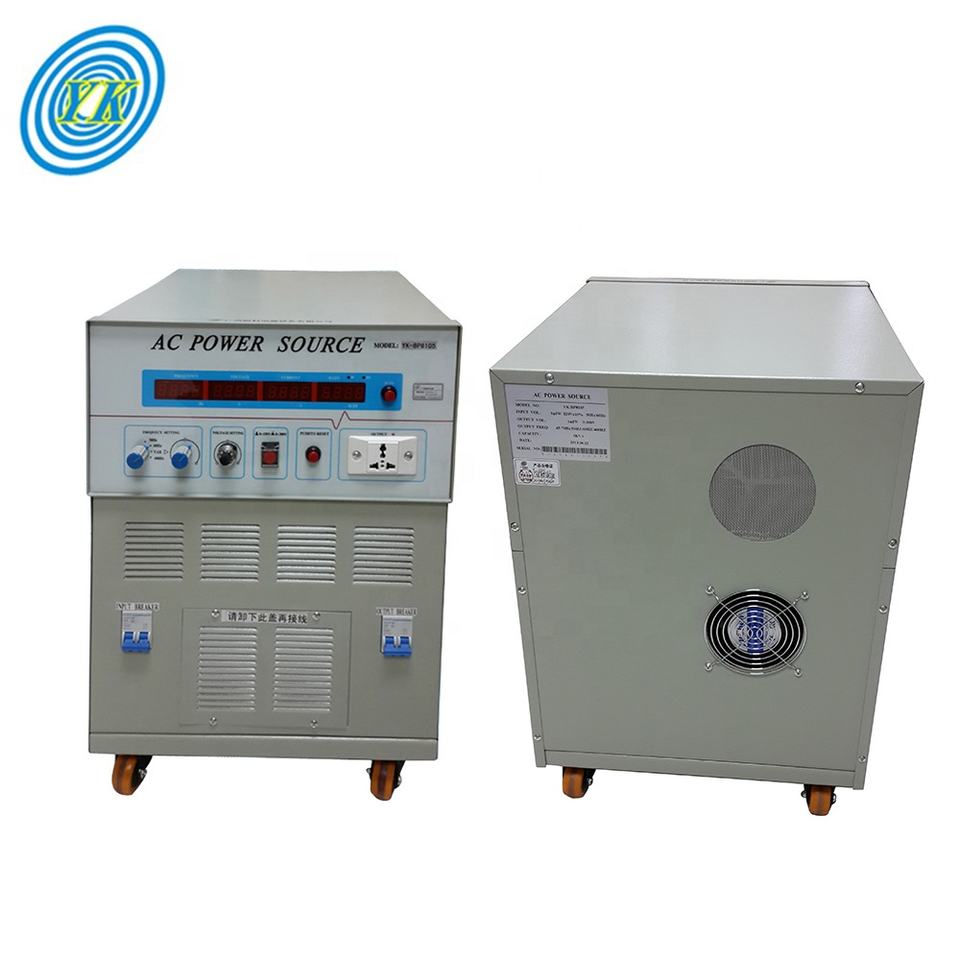
Exploring Variable Frequency Power Supplies: From Origins to Selection with a Special Focus on YUCOO
Click: 771 Date: 11/17/2023 08::38::59 AM
Exploring Variable Frequency Power Supplies: From Origins to Selection with a Special Focus on YUCOOIntroduction:Introduction and Origins of Variable Frequency Power SupplyA variable frequency power supply (VFPS), also known as a variable frequency drive or adjustable frequency drive, is a type of power supply that can change the frequency of the input power to the desired frequency. This technology is crucial for applications that require speed control of AC motors, as it allows for precise control of the speed and torque of the motor.The origins of VFPS can be traced back to the late 19th century when inventor Nikola Tesla first introduced the concept of variable frequency. However, it wasn't until the mid-20th century that the technology began to take shape in the form of rudimentary mechanical variable speed drives. The advent of solid-state electronics and microprocessors in the 1960s and 1970s, respectively, revolutionized the development of VFPS, enabling more compact, efficient, and reliable designs.Over the years, VFPS has undergone significant evolution in terms of technology and application. From the early mechanical designs, we have moved to modern VFPS that use advanced electronics and software algorithms to provide precise and energy-efficient control of AC motors.The impact of VFPS on various industries has been transformative. In industries like manufacturing, mining, and HVAC (Heating, Ventilation, and Air Conditioning), VFPS has enabled significant energy savings and improved process control. By allowing motors to run only at the necessary speed, VFPS reduces energy consumption and wear and tear on the equipment, leading to lower operational costs and extended equipment life.In the renewable energy sector, VFPS plays a key role in wind turbines, where it adjusts the generator speed to match varying wind speeds, maximizing power generation efficiency. In the water industry, VFPS controls pump speed to meet fluctuating demand, reducing energy use and preventing water hammer.As the demand for energy efficiency and process optimization continues to grow across industries, the role of VFPS is set to become even more critical in the future.Different Types of Variable Frequency Power SuppliesVariable Frequency Power Supplies (VFPS) come in various types, each with its own characteristics and uses. Here are some of the most common types:Volts/Hertz (V/Hz) Control: This is the simplest and most common type of VFPS. It maintains a constant ratio of voltage to frequency to control motor speed. It's best suited for applications that don't require high-performance speed control, like pumps and fans.Sensorless Vector Control (SVC): This type of VFPS provides better speed and torque control compared to V/Hz control. It does this without needing a feedback sensor, hence the name 'sensorless'. SVC is useful in applications where precision control is required, such as conveyors and mixers.Closed-loop Vector Control (CLVC): This is the most sophisticated type of VFPS. It uses a feedback sensor to achieve the highest precision in speed and torque control. It's typically used in high-performance applications like machine tools and robotics.YUCOO, with its extensive experience and expertise, caters to these diverse types of VFPS. They offer a wide range of products, from simple V/Hz control drives for basic applications to advanced CLVC drives for high-precision tasks.YUCOO's V/Hz control drives, like the YC6000 series, are designed for simplicity and reliability. They're easy to install and operate, making them ideal for applications like pumps and fans.For applications requiring more precise control, YUCOO offers the YC6100 series. These drives use SVC technology to provide superior performance compared to standard V/Hz drives.Finally, for the most demanding applications, YUCOO offers the YC6200 series. These drives feature CLVC technology, providing the highest level of precision and control. They're suitable for applications like machine tools and robotics, where precise speed and torque control are critical.In summary, no matter the type or complexity of the application, YUCOO has a VFPS solution to meet the needs.How to Choose a Good Variable Frequency Power SupplyChoosing a suitable Variable Frequency Power Supply (VFPS) is a critical task that involves several factors:Application Requirements: The first step is to understand your application requirements. This includes the type of load (motor, pump, fan, etc.), required speed range, torque requirements, and any special operating conditions. Knowing these will help you choose a VFPS that can meet your specific needs.Power Rating: The power rating of the VFPS should match the power requirements of your application. A VFPS with a higher power rating than necessary will lead to unnecessary costs, while one with a lower power rating may not perform adequately.Control Method: As discussed earlier, there are different types of VFPS based on the control method (V/Hz, SVC, CLVC). Choose the one that provides the appropriate level of control for your application.Ease of Use: Consider the ease of installation, operation, and maintenance of the VFPS. A user-friendly interface, clear instructions, and accessible customer support can make a significant difference.Reliability and Durability: Check the product's lifespan and reliability. High-quality components and robust build quality contribute to the durability of the VFPS, ensuring it can withstand the demands of your application.Price and After-sales Service: Price is an important factor, but it should not be the only one. Consider the after-sales service and warranty offered by the manufacturer as these can significantly impact the total cost of ownership.When it comes to these factors, YUCOO's products stand out. Their wide range of VFPS caters to various application requirements and power ratings. Whether you need a simple V/Hz control for a pump or an advanced CLVC control for a machine tool, YUCOO has a solution.YUCOO's products are designed with user-friendliness in mind. They are easy to install and operate, with clear instructions and responsive customer support. The high-quality components and robust construction of YUCOO's VFPS ensure reliability and durability, even in demanding operating conditions.Finally, YUCOO offers competitive prices and excellent after-sales service, including a comprehensive warranty. This makes YUCOO's VFPS not only a high-quality choice but also a cost-effective one.Understanding the Features of Variable Frequency Power SuppliesVariable Frequency Power Supplies (VFPS) come with several key features that make them an essential tool in many industries. Here are some of the main features:Variable Frequency Control: As the name suggests, the primary feature of a VFPS is its ability to vary the frequency of the power supply. This allows for precise control of the speed and torque of AC motors.Energy Efficiency: By allowing motors to run only at the necessary speed, VFPS can significantly reduce energy consumption compared to traditional fixed-speed motor systems.Soft Start Capability: VFPS can gradually ramp up the motor speed, preventing a sudden surge in power and reducing mechanical stress on the motor and other equipment.Protective Functions: Modern VFPS often come with built-in protective functions, such as overvoltage, undervoltage, overcurrent, overtemperature, and short-circuit protection.These features bring several benefits. Variable frequency control and energy efficiency can lead to substantial energy savings and improved process control. The soft start capability can extend the service life of the equipment by reducing mechanical stress. Protective functions enhance the safety and reliability of the system.However, there can also be potential drawbacks. For instance, VFPS can generate electrical and mechanical noise, which may require additional mitigation measures. Also, the initial cost of VFPS can be higher than traditional fixed-speed motor systems, although the energy savings typically offset this in the long run.YUCOO's VFPS products incorporate all these features and more. Their drives not only offer variable frequency control but also advanced control methods like V/Hz, SVC, and CLVC for superior performance. They are designed for energy efficiency, helping customers save on energy costs.YUCOO's VFPS also feature soft start capability, reducing mechanical stress on the equipment. Moreover, they come with comprehensive protective functions for enhanced safety and reliability.Despite the potential for electrical and mechanical noise, YUCOO's drives are designed with noise reduction measures to minimize this issue. And while their products represent an investment, the energy savings, improved process control, and extended equipment life they offer make them a cost-effective solution in the long run.A Detailed Introduction to YUCOO, a Renowned Manufacturer of Variable Frequency Power SuppliesYUCOO is a leading manufacturer of Variable Frequency Power Supplies (VFPS), with over 20 years of experience in the industry. Founded in the early 2000s, the company has since grown to become a globally recognized brand, known for its quality products and innovative solutions.YUCOO offers a wide range of VFPS products, catering to diverse application requirements and power ratings. Their product line includes the YC6000 series for simple V/Hz control applications, the YC6100 series for applications requiring superior performance with Sensorless Vector Control, and the YC6200 series for high-precision tasks requiring Closed-loop Vector Control.What sets YUCOO apart is their commitment to quality and innovation. They invest heavily in research and development to stay at the forefront of VFPS technology. Their products are designed for user-friendliness, reliability, and durability, making them a trusted choice for customers worldwide.YUCOO's achievements in the industry are significant. They have developed a range of innovative products that have pushed the boundaries of what's possible with VFPS. Their products have been used in various industries, including manufacturing, mining, HVAC, renewable energy, and water treatment, to name a few.Customer testimonials and reviews attest to the quality and reliability of YUCOO's products. Customers often praise the performance and durability of YUCOO's VFPS, as well as their excellent customer service. Here are a few examples:"We've been using YUCOO's drives in our manufacturing plant for several years now. They're reliable, efficient, and easy to use. We couldn't be happier with their performance." - Manufacturing Industry Customer"YUCOO's customer service is top-notch. They helped us choose the right drives for our application and were there to support us when we needed it." - HVAC Industry CustomerIn conclusion, YUCOO is a reputable manufacturer of VFPS that combines quality, innovation, and customer service. Their extensive experience and commitment to excellence make them a leading choice in the industry.
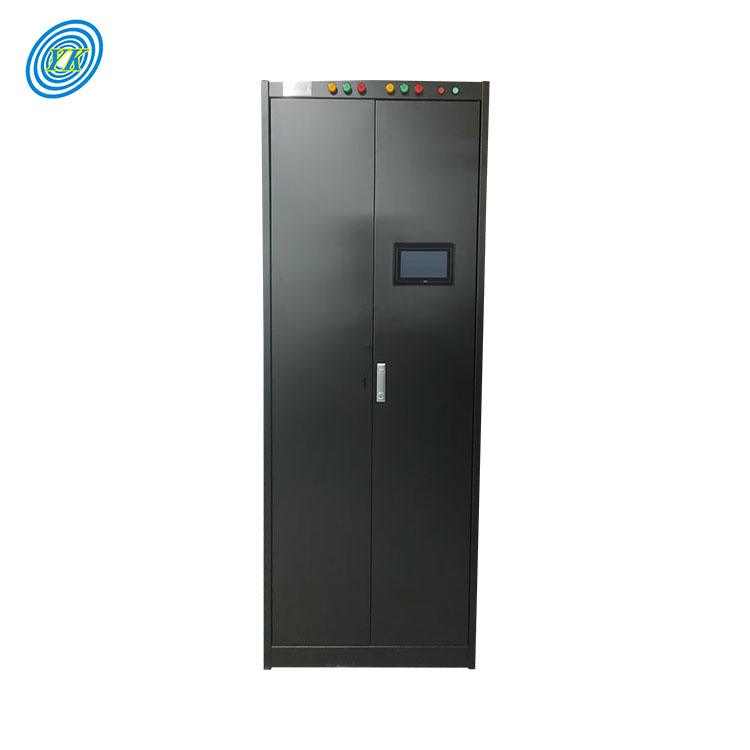
Click: 833 Date: 11/15/2023 2::24::20 PM
Mastering Electrical Distribution Cabinets: From Origins to Selection and Understanding Features with a Spotlight on YUCOOIntroduction:The Origin and Introduction of Electrical Distribution CabinetsElectrical distribution cabinets, also known as breaker panels or distribution boards, are a critical component in the electrical supply system. They play a vital role in distributing electrical power from one supply circuit to multiple subsidiary circuits, providing a protective fuse or circuit breaker for each circuit in a common enclosure.Origins of Electrical Distribution CabinetsThe concept of electrical distribution can be traced back to the late 19th century, when electricity started to be used for lighting and power. As the demand for electricity grew, so did the need for a system to distribute it safely and efficiently. Early distribution systems were rudimentary and often unsafe. Over time, improvements in technology and safety standards led to the development of the modern electrical distribution cabinet.The first versions of what we now call a distribution cabinet were simple fuse boxes. These were metal boxes containing a series of fuses for different circuits. The fuse would blow if the current exceeded its rated capacity, protecting the rest of the circuit from damage.As electrical systems became more complex and the demand for electricity increased, fuse boxes evolved into more sophisticated distribution panels. Circuit breakers replaced fuses, providing more reliable and safer overcurrent protection.Introduction to Electrical Distribution CabinetsToday's electrical distribution cabinets are highly sophisticated pieces of equipment. They are designed to handle a wide range of electrical loads, from small residential systems to large industrial installations.The main function of an electrical distribution cabinet is to distribute electrical power from one source to multiple circuits. It does this via a series of circuit breakers or fuses, each of which protects a separate circuit.In addition to distributing power, distribution cabinets also provide a level of safety. The circuit breakers or fuses in the cabinet are designed to trip or blow if the current in a circuit exceeds a safe level. This helps to prevent electrical fires and other damage.Modern distribution cabinets are usually made of metal and come in various sizes and configurations, depending on the needs of the electrical system. They may also include additional features such as surge protectors and ground fault circuit interrupters (GFCIs) for added safety.In the next sections, we will explore different types of electrical distribution cabinets, how to choose a good one, and the unique features of distribution cabinets from YUCOO, a renowned manufacturer with over 20 years of industry experience.Different Types of Electrical Distribution CabinetsElectrical distribution cabinets come in several types, each designed for specific applications and requirements. The main types can be broadly categorized into the following:1. Main Breaker PanelThe main breaker panel is the most common type of electrical distribution cabinet found in residential and small commercial buildings. It has a large circuit breaker that controls the power supply to the entire building and several smaller circuit breakers for individual circuits. The main breaker provides a quick way to shut off all power in case of an emergency.2. Sub-PanelA sub-panel is a smaller distribution cabinet that is connected to the main breaker panel. It is often used to extend the electrical system to a new part of the building, such as an addition, basement, or garage. Sub-panels have their own set of circuit breakers but do not have a main breaker.3. Transfer SwitchesThese are specialized electrical distribution cabinets used in buildings with backup power systems, such as generators. A transfer switch quickly switches the power source from the main supply to the backup generator in case of a power outage, and vice versa when the main power returns.4. Load CentersLoad centers are similar to main breaker panels, but they are typically smaller and used in residential buildings with lower power requirements. They have a main breaker and several circuit breakers for individual circuits.5. Motor Control CentersMotor control centers (MCCs) are large electrical distribution cabinets used in industrial applications. They contain starters and speed controls for multiple electric motors in a centralized location. They can be standalone or connected to other MCCs to control a large number of motors.Each type of electrical distribution cabinet has its unique features and applications. When choosing a cabinet, it's crucial to consider the specific needs of your electrical system. In the next section, we will discuss how to select a good electrical distribution cabinet, with a focus on YUCOO's offerings, a renowned manufacturer with over 20 years of industry experience.How to select a Good Electrical Distribution CabinetChoosing the right electrical distribution cabinet is crucial for the safety and efficiency of your electrical system. Here are some key factors to consider:1. Load RequirementThe first step in selecting a distribution cabinet is to calculate your electrical load, which is the total amount of power your system needs. This will help determine the size and type of cabinet you require.2. Type of BuildingThe type of building also plays a significant role in the selection process. Residential, commercial, and industrial buildings each have different power requirements and safety standards.3. Safety StandardsEnsure the distribution cabinet meets the relevant safety standards. This typically means it should be UL (Underwriters Laboratories) listed or equivalent, indicating it has been tested and certified for safety.4. Quality of MaterialsThe quality of the materials used in the construction of the cabinet can significantly impact its durability and safety. Cabinets should be made of high-quality, durable materials that can withstand the demands of the electrical system.5. Manufacturer's ReputationChoose a cabinet from a reputable manufacturer. A well-established company with a history of producing high-quality products is more likely to provide a reliable, durable distribution cabinet.6. FeaturesLook for additional features that may be beneficial, such as surge protection, ground fault circuit interrupters (GFCIs), or arc fault circuit interrupters (AFCIs).Considering these factors, YUCOO's electrical distribution cabinets stand out as a top choice. With over 20 years of industry experience, YUCOO is well-known for its high-quality, reliable products. Their cabinets meet all relevant safety standards and are made from top-quality materials, ensuring durability and longevity. Furthermore, YUCOO offers a range of cabinets suitable for different applications, from residential to industrial, with various additional features for enhanced safety and efficiency.In the next topic, we will delve deeper into the unique features of electrical distribution cabinets, with a focus on YUCOO's offerings.Understanding the Features of Electrical Distribution CabinetsUnderstanding the features of electrical distribution cabinets is essential for their proper use and maintenance. These features not only determine the functionality of the cabinet but also contribute to the safety and efficiency of your electrical system. Let's take a look at some of the key features:1. Circuit Breakers or FusesThese are the main components of any electrical distribution cabinet. They protect each circuit by interrupting the electrical flow if the current exceeds a safe level. Modern cabinets typically use circuit breakers, which can be reset after they trip, while older or simpler systems may use fuses that need to be replaced when they blow.2. Main BreakerThe main breaker controls the power to all the circuits in the cabinet. It allows for quick shutdown of the entire electrical system in case of an emergency.3. Bus BarsBus bars are metal strips that distribute power from the main breaker to the individual circuit breakers. They must be made of high-conductive materials, like copper or aluminum, to effectively distribute electricity.4. Neutral and Ground BarsThese bars provide pathways for the electrical current to return safely to the ground. They play a crucial role in preventing electrical shocks.5. Cabinet EnclosureThe cabinet enclosure houses all the components and protects them from dust, moisture, and physical damage. It should be made of durable, non-conductive materials.6. Surge ProtectorsSome cabinets include built-in surge protectors to protect the electrical system from voltage spikes.7. Ground Fault Circuit Interrupters (GFCIs) and Arc Fault Circuit Interrupters (AFCIs)These advanced features provide additional protection against electrical shocks and fires.When it comes to these features, YUCOO's electrical distribution cabinets are designed with high standards of safety and efficiency. Their cabinets are equipped with high-quality circuit breakers, durable bus bars, and robust enclosures. They also offer cabinets with built-in surge protectors, GFCIs, and AFCIs for enhanced safety. With over 20 years of industry experience, YUCOO's commitment to quality and innovation is evident in the features of their distribution cabinets.In the next topic, we will take a closer look at YUCOO, a renowned manufacturer of electrical distribution cabinets.An In-depth Look at YUCOO, a Renowned Manufacturer of Electrical Distribution CabinetsYUCOO is a highly reputable manufacturer in the electrical distribution cabinet industry. With over two decades of experience, the company has established itself as a leader in the field, offering a wide range of high-quality products that meet the diverse needs of customers worldwide.Company OverviewFounded over 20 years ago, YUCOO has dedicated itself to the production and development of electrical distribution cabinets. The company has built a strong reputation for its commitment to quality, innovation, and customer service. YUCOO's products are used in various sectors, including residential, commercial, and industrial settings, testifying to their versatility and reliability.Product RangeYUCOO offers an extensive range of electrical distribution cabinets designed to cater to a variety of needs. From main breaker panels, sub-panels, transfer switches, load centers, to motor control centers, YUCOO's product line is comprehensive. This allows customers to choose the perfect cabinet that fits their specific requirements and preferences.Quality and SafetyYUCOO places a strong emphasis on the quality and safety of its products. All their cabinets are made from high-quality materials, ensuring durability and longevity. Furthermore, YUCOO's products meet all relevant safety standards, providing customers with the assurance that they are investing in a safe and reliable solution for their electrical distribution needs.InnovationYUCOO is committed to innovation, continually investing in research and development to improve their products and meet the evolving needs of their customers. Their cabinets often feature advanced technologies like surge protection, ground fault circuit interrupters (GFCIs), and arc fault circuit interrupters (AFCIs) for enhanced safety and efficiency.Customer ServiceYUCOO prides itself on its excellent customer service. The company provides comprehensive support to its customers, from the selection process to installation and maintenance, ensuring a smooth and satisfying experience.In conclusion, if you're looking for a reliable, high-quality electrical distribution cabinet, YUCOO is a manufacturer that stands out in the industry. With their extensive experience, wide product range, commitment to quality and safety, innovative approach, and excellent customer service, YUCOO is a top choice for electrical distribution solutions.
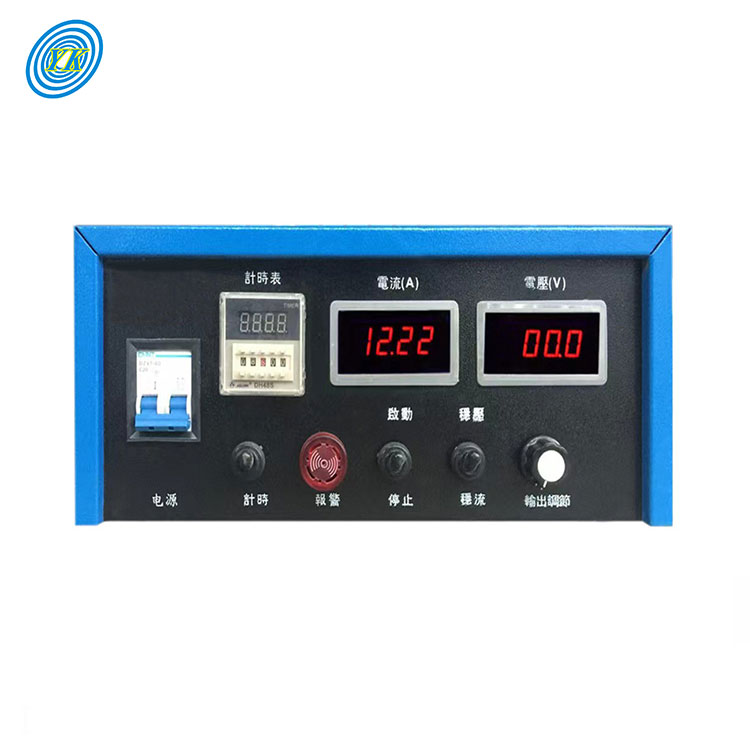
Click: 846 Date: 11/14/2023 2::47::32 PM
Switching Power Supplies: Their History, Types, Selection Guide, Characteristics, and a Spotlight on YUCO's Contribution to the IndustryIntroduction:The Origins and Evolution of Switching Power SuppliesSwitching power supplies, also known as switch-mode power supplies (SMPS), have a long and fascinating history. They were initially developed in the late 1920s and early 1930s to meet the needs of the growing radio broadcasting industry. The early versions of these supplies used mechanical switches or relays to convert input voltage to a desired output voltage.In the 1950s, with the advent of the transistor, the design of switching power supplies was revolutionized. Transistors allowed for smaller, lighter, and more efficient power supplies by switching the current on and off at a high frequency, which significantly reduced the size of the transformers and capacitors required.The 1970s and 1980s saw further improvements in the design of SMPSs. This period marked the introduction of pulse-width modulation (PWM), a technique that allows for precise control of the output voltage. This made SMPSs even more efficient and reliable.In the 1990s and early 2000s, the growing demand for portable electronic devices like laptops and cell phones led to the development of even smaller and more efficient SMPSs. This was achieved through advancements in semiconductor technology, which allowed for the creation of smaller and more efficient transistors.In the present day, switching power supplies are ubiquitous and an integral part of our daily lives. They are found in nearly all electronic devices, from computers and televisions to cell phones and electric vehicles. As technology continues to evolve, so does the design and efficiency of switching power supplies.Throughout this evolution, manufacturers like YUCOO have played a crucial role. With over 20 years of experience in the industry, YUCOO has consistently been at the forefront of innovation, developing high-quality, reliable, and efficient switching power supplies that meet the changing needs of consumers and industries.Various Types of Switching Power SuppliesSwitching power supplies come in various types, each with unique features designed to cater to specific requirements. Here are some of the most common types:DC-DC Converters: These power supplies convert a source of direct current (DC) from one voltage level to another. They are commonly used in portable devices like laptops and cell phones, as well as in electric vehicles.AC-DC Converters: Also known as power supply units (PSUs), these devices convert alternating current (AC) from the power mains to DC. They are used in a wide variety of applications, including computers, televisions, and other household electronics.Forward Converters: These are a type of SMPS that uses a transformer to increase or decrease the output voltage. They are typically used in applications that require a regulated and isolated DC voltage.Flyback Converters: These are used in applications that require electrical isolation between the input and output, such as in medical and telecom equipment.Buck Converters: These step down the input voltage to a lower level. They are commonly used in power management applications for microprocessors and other digital logic circuits.Boost Converters: These step up the input voltage to a higher level. They are used in applications like battery charging and power factor correction.Each of these types of switching power supplies offers specific advantages, such as high efficiency, compact size, or the ability to provide a regulated output voltage under varying load conditions.YUCOO, with its extensive experience and expertise, provides a diverse range of switching power supplies to cater to these different needs. Whether it's a DC-DC converter for a portable device, an AC-DC converter for a home appliance, or a specialized converter for industrial applications, YUCOO has a solution. The company's commitment to quality and innovation ensures that its products are reliable, efficient, and built to last.How to Choose a High-Quality Switching Power SupplyChoosing a high-quality switching power supply involves several key factors:Reliability: Look for a power supply that has a proven track record of long-term performance. It should be able to operate effectively under various conditions without failure. Features like over-voltage, over-current, and short-circuit protection can enhance reliability.Efficiency: High efficiency is desirable as it means less energy is wasted as heat, leading to lower operating costs and less demand on cooling systems.Power Rating: The power supply should be able to deliver the required power for your device or system. It’s generally a good idea to choose a power supply with a power rating 20-30% higher than your system’s peak power consumption to allow for potential future expansion.Regulation: Good regulation ensures that the output voltage or current remains constant under varying load conditions.Cost-effectiveness: While it's important to consider the initial cost of the power supply, also consider the total cost of ownership, which includes factors like energy costs and potential maintenance costs.Manufacturer Reputation: Choose a power supply from a reputable manufacturer that stands behind their products and offers good customer service and technical support.YUCOO's switching power supplies excel in all these areas. They are known for their reliability, having been rigorously tested under various conditions to ensure they meet high standards of performance. They also offer high efficiency, contributing to energy savings and lower operating costs for users. YUCOO offers a wide range of power ratings to suit different needs, and their power supplies have excellent regulation to provide stable output.In terms of cost-effectiveness, YUCOO's power supplies are competitively priced without compromising on quality or performance. Finally, as a reputable manufacturer with over 20 years of experience in the industry, YUCOO offers excellent customer service and technical support, standing behind their products with confidence.Understanding the Characteristics of Switching Power SuppliesSwitching power supplies have several unique characteristics that benefit users:Efficiency: Switching power supplies, particularly those using pulse-width modulation (PWM), are highly efficient. They convert the electrical energy from the input source to the output with a high degree of efficiency, meaning less energy is wasted as heat. This results in lower operating costs for the user.Compact Size: Thanks to the use of high-frequency switching, switching power supplies are typically smaller and lighter than traditional linear power supplies. This makes them ideal for use in portable devices like laptops and smartphones.Rapid On/Off Control: Switching power supplies can switch on and off very quickly, usually in the range of microseconds to milliseconds. This rapid switching allows for a high-frequency output waveform, which can improve the performance of the connected electronic devices.Regulation: Switching power supplies are capable of maintaining a constant output voltage, even under varying load conditions. This is particularly useful for sensitive electronic devices that require a stable power supply.Protection Features: Many switching power supplies include protection features such as over-voltage, over-current, and short-circuit protection. These features can help to prevent damage to the connected electronic devices and extend the lifespan of the power supply.YUCOO's products exemplify these characteristics. Their power supplies are designed to offer high efficiency, compact size, and rapid on/off control. They also include robust protection features to ensure the longevity of the power supply and the safety of the connected devices. YUCOO's commitment to quality ensures that their power supplies deliver a stable, reliable, and high-performing power solution.An In-depth Look at YUCOO, a Renowned Manufacturer of Switching Power SuppliesYUCOO, established in 2003, is a renowned manufacturer of switching power supplies. With over 20 years of experience in the industry, YUCOO has consistently been at the forefront of innovation, developing high-quality, reliable, and efficient switching power supplies that meet the changing needs of consumers and industries.The company's product range is diverse and extensive, catering to a wide variety of applications. Whether it's a DC-DC converter for a portable device, an AC-DC converter for a home appliance, or a specialized converter for industrial applications, YUCOO has a solution. The company's products are known for their high efficiency, compact size, and excellent regulation, making them ideal for a wide range of applications.YUCOO's reputation in the industry is built on its commitment to quality and innovation. The company's products are rigorously tested under various conditions to ensure they meet high standards of performance. This commitment to quality is reflected in the reliability and durability of YUCOO's power supplies.In addition to their quality, YUCOO's products are also known for their cost-effectiveness. While it's important to consider the initial cost of the power supply, also consider the total cost of ownership, which includes factors like energy costs and potential maintenance costs. YUCOO's power supplies are competitively priced without compromising on quality or performance.YUCOO's expertise and commitment to quality have earned it a reputation as a leading manufacturer in the switching power supply industry. The company's products are trusted by consumers and industries worldwide, and its commitment to innovation ensures that it will continue to be a leader in this field.
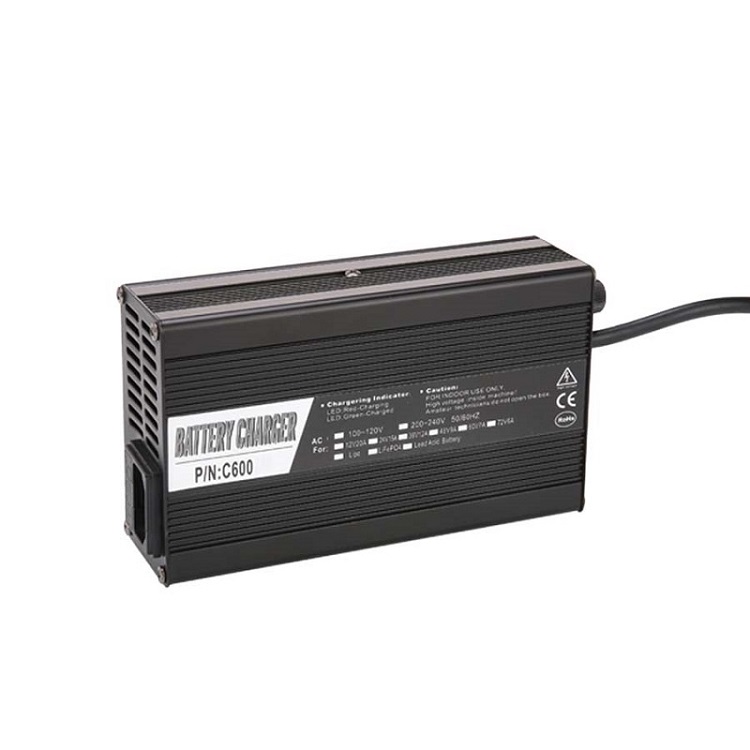
Click: 859 Date: 11/13/2023 10::44::00 AM
Understanding the Evolution, Varieties, and Selection of Chargers: An In-depth Look into YUCOO's Contribution to the Charging IndustryIntroduction:The Origins and Evolution of ChargersThis section will delve into the history of chargers, starting from the early days when the concept of battery charging was first introduced, to the modern-day advanced chargers. The evolution of YUCOO in this field, with its 20 years of experience, will be a highlight in this section.The concept of battery charging dates back to the late 18th century with the invention of the voltaic pile by Alessandro Volta. This was the first true battery that provided a continuous and stable source of electricity, and it paved the way for the development of chargers.The first chargers were simple devices that used a transformer and a rectifier to convert AC power to DC to charge batteries. They were unregulated, meaning they would continue charging the battery even after it was fully charged, which could lead to overcharging and damage.The next major advancement came with the introduction of regulated chargers in the mid-20th century. These chargers included a voltage regulator that would stop charging once the battery reached a certain voltage, preventing overcharging.Fast forward to the 21st century, and we have smart chargers that not only prevent overcharging but also optimize the charging process to prolong battery life. These chargers use microprocessors to monitor and control the charging process, making them more efficient and safer than their predecessors.YUCOO has been at the forefront of these advancements in the charging industry. With over 20 years of experience, YUCOO has consistently introduced innovative chargers that meet the evolving needs of consumers. From basic chargers to intelligent ones, YUCOO's evolution mirrors that of the industry. Their commitment to quality and innovation has made them a trusted name in the charging industry.Over the years, YUCOO has developed a range of chargers for different applications, including domestic, commercial, and industrial uses. Their chargers are known for their reliability, efficiency, and advanced features, such as quick charging and automatic voltage regulation.YUCOO's journey in the charging industry exemplifies the evolution of chargers. From simple devices for converting AC to DC, chargers have evolved into sophisticated pieces of technology that ensure our devices are powered safely and efficiently. As we look to the future, companies like YUCOO will continue to drive innovation in this field, creating chargers that are even more efficient, safe, and tailored to our needs.Different Types of ChargersThis segment will discuss the various types of chargers available in the market, including wall chargers, car chargers, portable chargers, and wireless chargers. It will also cover the diverse range of chargers that YUCOO manufactures, emphasizing their unique features and uses.In today's digital age, there are several types of chargers available, each designed to meet a specific need.Wall Chargers: These are the most common type of chargers. They are designed to plug into a wall outlet and provide a direct power source for charging any compatible device. Wall chargers typically come with either a fixed or detachable cable.Car Chargers: These chargers are designed to be used in vehicles. They plug into the car's 12V accessory socket (commonly known as the cigarette lighter socket) and provide a convenient way to charge devices while on the move.Portable Chargers: Also known as power banks, these are compact, battery-operated chargers that can be used to charge devices on the go. They are especially useful when wall outlets are not readily available.Wireless Chargers: These chargers use electromagnetic fields to transfer energy between two objects. They eliminate the need for cables and provide a convenient and clutter-free charging solution.YUCOO manufactures a wide array of chargers, each tailored to meet the specific needs of different users.YUCOO Wall Chargers: These chargers are compact, reliable, and designed for everyday use. They come with built-in safety features such as overcharge protection, overheat protection, and short-circuit protection.YUCOO Car Chargers: YUCOO's car chargers are designed to withstand the harsh environment of vehicles. They come with features like fast charging and automatic voltage regulation to ensure safe and efficient charging.YUCOO Portable Chargers: YUCOO's power banks are lightweight, compact, and packed with high-capacity batteries. They offer multiple charging ports, allowing users to charge more than one device at a time.YUCOO Wireless Chargers: YUCOO's wireless chargers offer a seamless and convenient charging experience. They support fast charging and are compatible with a wide range of devices.YUCOO's diverse range of chargers is a testament to their commitment to innovation and customer satisfaction. Whether it's for home, on the road, or on the go, YUCOO has a charger that meets your needs.How to Choose a Good Charger This part will provide a guide on how to select a good charger based on factors such as the device's power requirements, the charger's output current, and safety features. The exceptional qualities that make YUCOO chargers a good choice will be underscored in this section.Choosing the right charger is crucial for the longevity of your device and safety. Here are some factors to consider:Power Requirements: Check your device's power requirements usually listed in the manual or on the device itself. The charger's output voltage should match the device's input voltage.Output Current: This is measured in amperes (A). A higher output current allows for faster charging, but make sure your device can handle it, or it could damage the battery.Safety Features: Look for chargers with safety features such as overcharge, overheating, and short-circuit protection. These features protect your device and the charger from potential damage.Quality and Durability: A good charger should be well-built and durable. It should be capable of withstanding regular plugging and unplugging.Brand Reputation: Choose a charger from a reputable brand. They are likely to comply with safety standards and offer a warranty.YUCOO chargers stand out in all these aspects:Power Compatibility: YUCOO chargers come in a range of power outputs to suit different devices.High Output Current: YUCOO offers fast chargers with high output current for devices that support it.Safety Features: YUCOO chargers are equipped with multiple safety features, ensuring a safe charging process.Quality and Durability: YUCOO chargers are built to last, with high-quality materials and robust construction.Brand Reputation: With over 20 years in the industry, YUCOO is a trusted name in the charging industry. Their chargers meet international safety standards and come with a warranty.In conclusion, when choosing a charger, consider your device's power requirements, the charger's output current, safety features, and the reputation of the brand. YUCOO chargers excel in all these areas, making them a worthy choice.Understanding the Features of Chargers This section will explain the different features of chargers, such as output voltage, current, quick charging capability, and safety mechanisms. Here, the specific features of YUCOO chargers that set them apart will be discussed in detail.Chargers come with a variety of features that cater to different user needs. Here are some of the key features:Output Voltage: This is the voltage at which the charger can deliver power. It should match the input voltage of the device being charged.Output Current: This is the maximum amount of electric current that the charger can deliver. A higher output current allows for faster charging.Quick Charging Capability: This feature allows the charger to deliver a higher amount of current, enabling faster charging times. It's particularly useful for devices with large batteries.Safety Mechanisms: These include overcharge protection, overheating protection, and short-circuit protection. These features protect both the charger and the device from potential damage.YUCOO chargers are equipped with these features, and here's how they stand out:High Output Voltage and Current: YUCOO chargers are designed to deliver high output voltage and current, ensuring fast charging times.Quick Charging Capability: YUCOO offers quick charging technology on many of their chargers. This feature allows for faster charging times, which is particularly beneficial for devices with large batteries.Advanced Safety Features: YUCOO chargers are equipped with advanced safety features, including overcharge, overheating, and short-circuit protection. These features ensure a safe charging process and prolong the lifespan of the charger and the device.Automatic Voltage Regulation: Some YUCOO chargers feature automatic voltage regulation. This feature adjusts the output voltage in real time to match the device's power requirements, ensuring optimal charging efficiency.In conclusion, the features of a charger play a crucial role in its performance and safety. YUCOO chargers, with their high output voltage and current, quick charging capability, and advanced safety features, are designed to provide optimal charging efficiency and safety.A Detailed Introduction to YUCOO, a Renowned Charger Manufacturer This final section will provide an in-depth introduction to YUCOO, detailing their journey in the charging industry, their commitment to quality and innovation, and their global reach. The salient features of YUCOO chargers will be highlighted to illustrate their contribution to the industry.YUCOO is a renowned name in the charging industry, known for its commitment to quality and innovation. With over 20 years of experience, YUCOO has been at the forefront of the charging industry, introducing innovative chargers that have evolved with the times.YUCOO's journey in the charging industry began in the late 2000s. Since then, they have consistently introduced new products and technologies, always staying ahead of the curve. Their dedication to quality is evident in their products, which are known for their reliability, efficiency, and advanced features.One of the key aspects of YUCOO's success is their commitment to innovation. They continuously research and develop new technologies to improve their chargers. For instance, they introduced quick charging technology in their chargers, enabling faster charging times for devices with large batteries. They also developed chargers with automatic voltage regulation, ensuring optimal charging efficiency.YUCOO's chargers are not just limited to domestic use. They have a wide range of chargers suitable for commercial and industrial applications. Their chargers are designed to withstand the demands of these environments, ensuring reliable and efficient charging.Another significant aspect of YUCOO is their global reach. Their chargers are sold in over 100 countries worldwide, demonstrating their international recognition and acceptance.In terms of features, YUCOO chargers stand out with their high output voltage and current, quick charging capability, and advanced safety features. These features ensure a safe and efficient charging process, making YUCOO chargers a popular choice among consumers.In conclusion, YUCOO has made significant contributions to the charging industry. With their commitment to quality and innovation, YUCOO has established itself as a trusted name in the industry. Their chargers, with their high output voltage and current, quick charging capability, and advanced safety features, continue to meet the evolving needs of consumers.
